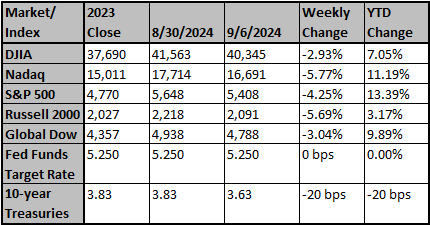Friday’s employment report suggests the US economy may be slowing down faster than most investors think.
Nonfarm payrolls increased by 142,000 in August, but revisions to June and July brought the net gain down to a modest 56,000. And the details were worse. We like to follow payrolls excluding three sectors: government, education & health services, and leisure & hospitality, all of which are heavily influenced by government spending and regulation (including COVID lockdowns and reopening’s for leisure & hospitality). That “core” measure of payrolls rose only 25,000 in August and is up only 31,000 total in the past three months.
In particular, government, education, and healthcare jobs have made up 37% of all the net payroll increases since the pre-COVID peak in February 2020, an unusually large share.
For August itself, things looked better if you focus on civilian employment, an alternative measure of jobs that includes small-business start-ups, which rose 168,000 for the month. However, it’s hard to make a strong case for the US economy if you stick with that civilian employment measure. The August gain was the largest in five months but civilian employment is down compared to a year ago, with a loss of 66,000 jobs. Even worse, full-time employment is down one million from a year ago while part-time employment is up 1.1 million over the same timeframe.
Another recent report from the Labor Department revised down the payroll increase in the year ending in March 2024 by 818,000. That makes sense given that payrolls had been previously estimated to have grown 2.9 million during this period while civilian employment was estimated to have grown 642,000. But even after reducing payroll growth by 818,000 that still leaves a large gap. One way to close that remaining gap is an upward revision to population numbers due to high immigration, which would lift civilian employment, as well. But another way would be an even larger downward revision to payrolls.
This week the Labor Department will report on inflation and we – and the consensus – expect a moderate 0.2% increase in consumer prices for the month of August. In turn, that would mean that CPI prices were up around 2.5% from a year ago, which should translate into PCE inflation (the Federal Reserve’s preferred measure) of 2.3%. That’s a big drop from the 3.3% gain in PCE prices in the year ending in August 2023 and suggests that by the early part of next year inflation may temporarily hit or go under the Fed’s 2.0% target.
Why is this happening? Why is the economy slowing and inflation decelerating? Because monetary policy has been tight. After surging in 2020-21, the M2 measure of the money supply peaked in early 2022. Although it’s been rising gradually since October, it’s still down 3.1% from the peak in April 2022.
The Fed obviously realizes this, hence all the talk about cutting short-term interest rates. For now, our base case is that the Fed will cut rates by a quarter percentage point at each of the three remaining meetings this year (starting next week) and continue that pattern well into 2025.
The problem is that the Fed still thinks it should focus on rates, not the money supply. If growth in M2 picks back up quickly, we risk a return to higher inflation, like we did multiple times in the 1970s. If growth in M2 remains lackluster in spite of rate cuts, the landing could get harder than anyone thinks.
Source: Brian S. Wesbury, Chief Economist First Trust
Chart reflects price changes, not total return. Because it does not include dividends or splits, it should not be used to benchmark performance of specific investments. Data provided by Refinitiv.
Sincerely,
Fortem Financial
(760) 206-8500
team@fortemfin.com
Latest News
Wall Street bounces as investors await inflation data, Fed rate cuts
Wall Street's three main stock indexes rose on Monday after a week of losses as investors looked for bargains while they waited for inflation reports in coming days and the Federal Reserve's next policy decision next week.
Reuters
NY Fed report finds mostly stable inflation expectations in August
The U.S. public's outlook for inflationary pressures was little changed last month amid an ongoing retreat in current price pressures, according to a report released on Monday by the New York Federal Reserve.
Reuters

